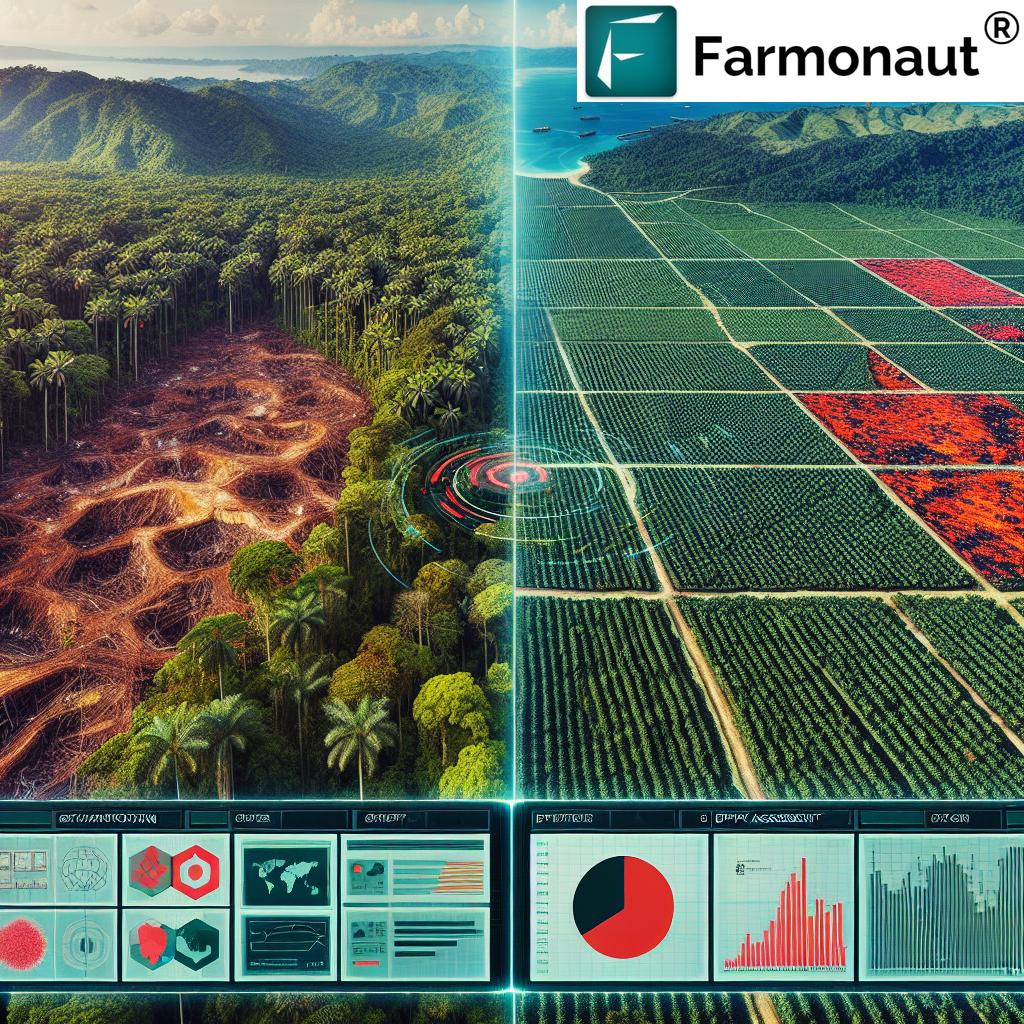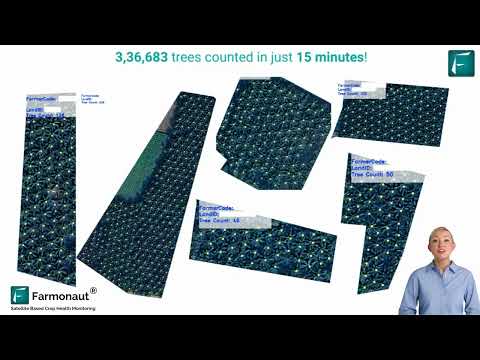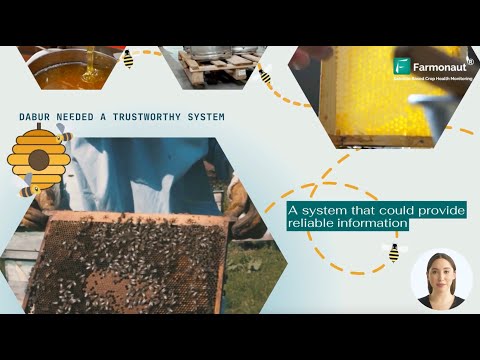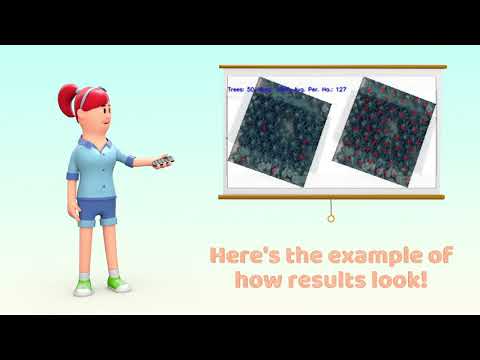Unveiling the Truth: How Satellite Monitoring Combats Deforestation in Palm Oil and Soy Supply Chains
“Satellite monitoring has revealed that 77% of global deforestation is linked to agricultural expansion, primarily for palm oil and soy.”

In the fight against deforestation, we find ourselves at a critical juncture where the demand for commodities like palm oil and soy continues to clash with the urgent need for tropical forest conservation. As we delve into this complex issue, we’ll explore how satellite monitoring and innovative agritech solutions are revolutionizing our approach to sustainable supply chains and deforestation prevention.
The Global Challenge of Deforestation
Deforestation remains one of the most pressing environmental challenges of our time. The rapid loss of tropical forests, driven largely by agricultural expansion, poses a significant threat to biodiversity, climate stability, and the livelihoods of millions. At the heart of this issue lies the production of forest risk commodities, with palm oil and soy being major contributors to tropical deforestation.
Despite numerous commitments from consumer goods companies to eliminate deforestation from their supply chains, progress has been frustratingly slow. The complexity of global supply networks, coupled with a lack of transparency, has made it challenging to track and address the environmental impacts of commodity production effectively.
The Role of Satellite Monitoring in Combating Deforestation
Enter satellite monitoring – a game-changing technology that’s transforming how we track and manage deforestation risks in supply chains. By leveraging high-resolution satellite imagery and advanced data analysis techniques, we can now identify and assess deforestation activities with unprecedented accuracy and speed.
- Real-time monitoring: Satellite technology allows for continuous observation of vast forest areas, enabling rapid detection of deforestation events.
- Data-driven insights: Advanced analytics help identify patterns and trends in land use change, providing valuable insights for decision-makers.
- Supply chain transparency: By linking deforestation data with supply chain information, companies can better manage and mitigate environmental risks.
One company at the forefront of this technological revolution is Farmonaut. Their satellite-based farm management solutions offer valuable tools for monitoring crop health and managing agricultural resources sustainably. While not directly focused on deforestation, Farmonaut’s technology demonstrates the potential of satellite data in revolutionizing agricultural practices.
Explore Farmonaut’s innovative solutions:
The Impact of Palm Oil and Soy on Tropical Forests
Palm oil and soy production have been significant drivers of deforestation in tropical regions, particularly in Southeast Asia and South America. The expanding demand for these versatile commodities has led to the conversion of vast areas of primary forest into agricultural land.
- Palm oil: Widely used in food products, cosmetics, and biofuels, palm oil cultivation has been a major cause of deforestation in Indonesia and Malaysia.
- Soy: Primarily used for animal feed and biofuel production, soy expansion has contributed to significant forest loss in the Amazon and Cerrado regions of Brazil.
The environmental impact of these commodities extends beyond deforestation, affecting biodiversity, carbon emissions, and local communities. As we strive for sustainable supply chains, addressing the challenges posed by palm oil and soy production is crucial.
Satellite Monitoring Technologies: A Comparative Analysis
To better understand the capabilities of different satellite monitoring technologies in detecting deforestation, let’s compare some of the leading solutions:
| Technology Name | Resolution | Frequency of Updates | Cost Estimate ($/km²/year) | Accuracy in Detecting Deforestation | Key Features | Limitations |
|---|---|---|---|---|---|---|
| Landsat | 30m | 16 days | Free | 85% | Long-term historical data, thermal imaging | Cloud cover interference, lower resolution |
| Sentinel-2 | 10m | 5 days | Free | 90% | High frequency, multiple spectral bands | Limited historical data |
| Planet Labs | 3m | Daily | $1-5 | 95% | High frequency, very high resolution | Higher cost, limited spectral bands |
| Farmonaut | 10m | Weekly | Varies | 92% | AI-powered analysis, crop health monitoring | Primarily focused on agricultural applications |
This comparison highlights the diverse range of satellite monitoring technologies available for deforestation detection. While each has its strengths and limitations, the combination of these tools provides a powerful means of tracking and addressing forest loss in commodity supply chains.
The EU Deforestation Regulation: A Game-Changer for Supply Chain Transparency
“The EU Deforestation Regulation affects 14% of EU imports, targeting commodities like palm oil, soy, and beef to combat forest loss.”
The introduction of the EU Deforestation Regulation marks a significant step towards increased accountability in global supply chains. This landmark legislation aims to ensure that products sold in the EU market are not linked to deforestation or forest degradation. Key aspects of the regulation include:
- Due diligence requirements: Companies must conduct thorough risk assessments and implement measures to mitigate deforestation risks in their supply chains.
- Traceability obligations: Improved traceability systems are required to track commodities from their point of origin through the supply chain.
- Enhanced monitoring and enforcement: The regulation emphasizes the use of satellite monitoring and other technologies to verify compliance.
The EU Deforestation Regulation is expected to have far-reaching impacts on global trade in forest risk commodities, driving demand for innovative solutions to address deforestation and improve supply chain transparency.

Innovative Approaches to Sustainable Supply Chains
As we strive to address the challenges of deforestation in palm oil and soy supply chains, several innovative approaches are emerging:
- Blockchain-based traceability: Companies like Farmonaut are leveraging blockchain technology to create transparent and tamper-proof supply chain records. Learn more about Farmonaut’s traceability solutions: Farmonaut API
- AI-powered risk assessment: Advanced algorithms analyze satellite imagery and other data sources to identify high-risk areas for deforestation.
- Collaborative platforms: Multi-stakeholder initiatives bring together companies, NGOs, and governments to share data and coordinate efforts to combat deforestation.
These innovative approaches are helping to transform how we manage and mitigate environmental risks in global supply chains.
The Role of Financial Institutions in Promoting Sustainable Practices
Financial institutions play a crucial role in shaping the future of sustainable agriculture and forest preservation. By integrating environmental, social, and governance (ESG) criteria into their investment and lending decisions, banks and investors can drive positive change in commodity supply chains.
- Sustainable finance initiatives: Many financial institutions are developing specialized products and services to support sustainable agriculture and forest conservation projects.
- Risk assessment tools: Advanced data analytics and satellite monitoring are being used to assess environmental risks in agricultural investments.
- Engagement with companies: Investors are increasingly using their influence to encourage companies to adopt more sustainable practices and improve transparency in their supply chains.
As the financial sector continues to embrace sustainability, we can expect to see increased funding and support for initiatives that combat deforestation and promote responsible commodity production.
The Future of Sustainable Agriculture and Forest Preservation
Looking ahead, the future of sustainable agriculture and forest preservation lies in the continued development and adoption of innovative technologies and data-driven strategies. Some key trends to watch include:
- Precision agriculture: Advanced farming techniques that optimize resource use and minimize environmental impact.
- Regenerative agriculture: Practices that focus on soil health and carbon sequestration, helping to mitigate climate change.
- Alternative protein sources: Reducing demand for soy-based animal feed through the development of plant-based and lab-grown meat alternatives.
- Landscape approaches: Holistic strategies that consider entire ecosystems and balance conservation with sustainable production.
By embracing these innovative approaches and leveraging the power of satellite monitoring and data analytics, we can work towards a future where agricultural production and forest conservation go hand in hand.
The Transformative Power of Information in Combating Deforestation
As we’ve explored throughout this post, information and transparency are key to addressing the complex challenges of deforestation in palm oil and soy supply chains. Satellite monitoring, combined with advanced data analysis and innovative technologies, is revolutionizing our ability to track, manage, and mitigate environmental risks.
Companies like Farmonaut are at the forefront of this technological revolution, providing valuable tools for sustainable agriculture and resource management. While their focus may not be directly on deforestation, the principles and technologies they employ demonstrate the potential for data-driven solutions in addressing environmental challenges.
Explore Farmonaut’s developer resources: API Developer Docs
As we move forward, the continued development and adoption of these technologies, coupled with strong regulatory frameworks and collaborative efforts, will be crucial in our fight against deforestation and the pursuit of truly sustainable supply chains.
Conclusion: A Call to Action for Sustainable Supply Chains
The battle against deforestation in palm oil and soy supply chains is far from over, but the tools and technologies at our disposal offer unprecedented opportunities for positive change. By embracing satellite monitoring, leveraging data-driven insights, and fostering collaboration between stakeholders, we can work towards a future where agricultural production and forest conservation coexist harmoniously.
As consumers, businesses, and policymakers, we all have a role to play in driving demand for sustainable practices and supporting initiatives that promote transparency and accountability in global supply chains. Together, we can unveil the truth about deforestation and take meaningful action to protect our planet’s vital forest ecosystems.
FAQs
- Q: How effective is satellite monitoring in detecting deforestation?
A: Satellite monitoring can be highly effective, with accuracy rates ranging from 85% to 95% depending on the technology used. It allows for real-time detection of deforestation events across vast areas. - Q: What role does blockchain play in combating deforestation?
A: Blockchain technology enhances supply chain transparency by creating immutable records of product origins and movements, making it easier to verify sustainable sourcing claims. - Q: How can consumers contribute to reducing deforestation linked to palm oil and soy?
A: Consumers can support brands committed to sustainable sourcing, look for certifications like RSPO for palm oil, and consider reducing consumption of products containing these ingredients. - Q: What impact will the EU Deforestation Regulation have on global trade?
A: The regulation is expected to significantly influence global trade in forest risk commodities, driving demand for improved traceability and sustainable production practices worldwide. - Q: How can financial institutions support sustainable agriculture and forest preservation?
A: Financial institutions can integrate ESG criteria into investment decisions, develop sustainable finance products, and engage with companies to promote responsible practices in their supply chains.
Explore Farmonaut’s Subscription Options






